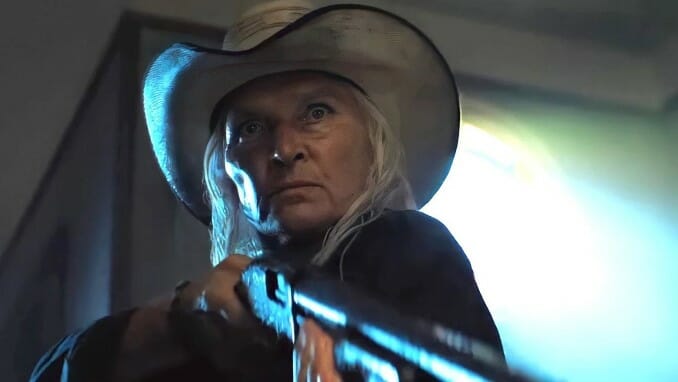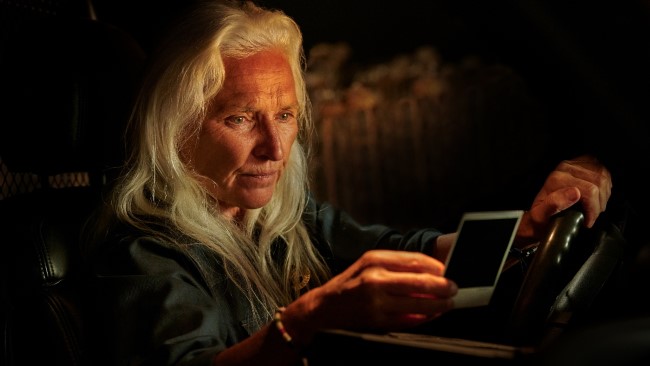Netflix’s Texas Chainsaw Massacre Is the Poster Child of Bad “Requel” Horror
Photos via Netflix Movies Features horror movies

It’s odd to watch a film and be acutely aware that its creation has been tightly shaped by the specificities of convention—and not the convention of long-held traditions, either, but conventions that have only properly existed for a few short years. Netflix’s new Texas Chainsaw Massacre is such an experience, with the absolute deference it displays not toward the areas you might expect, such as classic slasher movie tropes, but instead with its slavish appeasement of newly created tropes that power the concept of the “legacy requel.” The latest convention to become enshrined in the world of horror cinema, where sequelization and repetition have existed at the forefront of the genre since the 1980s, the idea of the “requel” has become an insipid standard-bearer for the modern age of nostalgia marketing, whether we’re talking about 2018’s Halloween or 2021’s Ghostbusters: Afterlife. And this Texas Chainsaw Massacre is effectively the new poster child of awkward requels, the most clumsy attempt we’ve yet seen to bolt the valued baubles of the past onto a shiny new present, in search of nostalgia dollars.
The fact that this new film, which is somehow the ninth in the TCSM franchise, arrived after 2022’s surprisingly fresh Scream only serves to highlight its many deficiencies, considering the incisive observations made by the latter about the soulless emptiness that can be found at the heart of requel culture. Where Scream went out of its way to analyze and justify the involvement of the so-called “legacy” characters, this new TCSM could never for a moment cling to any reasonable hope of doing the same. And it all boils down to the simplicity of the fact that 1974’s The Texas Chain Saw Massacre honestly didn’t have any protagonists in it that made sense to unearth and exploit all over again. Beyond its family of cannibals, it is bereft of interesting IP, but that didn’t stop screenwriter Chris Thomas Devlin from pretending otherwise.
Before the release of this new Netflix feature, in fact, could even most horror geeks have named the sole survivor of The Texas Chain Saw Massacre, a film that first lurched into cinemas almost half a century ago? Sally Hardesty was her name, but modern attempts to lionize this character as an “iconic final girl” primarily boil down to the primordial power of the original film’s final images: Sally crying and laughing hysterically as she’s delivered from the mouth of hell. She’s remembered for the movie she’s in, rather than anything the character does in that movie.
In truth, Sally was never a proper “final girl” by any sense that fans of the slasher genre would recognize from the 1980s onward, nor does she even feel like the primary protagonist for much of the film while one is watching the original Texas Chain Saw Massacre. She doesn’t valorously fight back against her antagonists like Nancy Thompson of A Nightmare on Elm Street, nor survive the ordeal via her wits and ingenuity. Instead, Sally is simply a lucky soul who happened to escape her fate, driven more by random chance than anything else—she ultimately gets away not because she turns the tables on the villain, but because a random truck driver happens to be passing by at the right time. The Sally Hardesty of 1974 is thus saved by chance, just as her friends were doomed by chance. This is a fittingly nihilistic sentiment for Tobe Hooper’s grungy horror classic, which is nothing like the formulaic, cheerful, teen-slashing romps that would follow in the 1980s—the original Texas Chain Saw Massacre is a film about the realistically random brutalities of an utterly uncaring universe. Cheap “entertainment” doesn’t even seem to be its primary objective.
To bring back that character, then—a character that a large portion of the modern target demographic (the Gen Z viewers in the house) will barely even recall or be familiar with in the first place—feels especially forced and desperate, an inclusion that only exists because the new convention of the requel demands that the “original survivor” must return as a narrative prop and supposed big money draw, whether or not there’s any narrative (or even economic) reason for it. Despite the fact that earthy, realistic Sally Hardesty is decidedly unlike the iconic, fully formed final girls who would follow, the film demands that Sally now conform to the archetype we’ve seen more recently for Halloween’s Laurie Strode or Scream’s Sidney Prescott. A hardened, avenging asskicker. The character is being jammed into a mold where she simply doesn’t fit. The filmmakers, meanwhile, can’t even play the “people will want to see the original actress” card, with Marilyn Burns, who played Sally in 1974, having sadly passed away back in 2014. There’s essentially no way to do this without it feeling exploitative.
 This Sally was apparently expecting Leatherface to show up at SXSW every year, only to be continuously disappointed.
This Sally was apparently expecting Leatherface to show up at SXSW every year, only to be continuously disappointed.
Nor can we buy the same boilerplate revenge motivation of the likes of Laurie Strode as applied to Sally, as the film can’t be bothered to think its way through the premise it’s asking you to accept. When watching 2018’s Halloween, it’s not particularly hard to buy that Laurie has been obsessed with Michael Myers since that fateful night, and has prepared in case he ever escapes from the mental institution once again. Sally, on the other hand, has supposedly been “hunting” for Leatherface for the last half a century in this new TCSM without ever finding the 7-foot mute. Where does he ultimately turn up? Well, living a few hours away from where the original massacre went down, actually—so close, in fact, that he walks back to the original farmhouse in the post-credits scene. Our badass avenging angel spent 50 years being unable to find and take her revenge upon this person. That’s not how you build an audience’s respect for a character’s basic competency. All it does is highlight the inherent absurdity of writing a “50 years later” sequel in the first place, with a story whose primary antagonist is a 76-year-old, 300 pound man who can still sprint like a gazelle and easily run down lithe high schoolers.
One almost gets the sense, in fact, that the character of Sally Hardesty is in this film under some kind of duress or protest, as if the screenwriter and director were forced to incorporate her under threat of punishment and responded by making her contribution as streamlined and ineffectual as possible. The result is a feeling of constant contradiction, in which Sally Hardesty functions as the central feature around which the story has been built, but simultaneously has barely any screen time. She was important enough to be a necessity in getting the film made, but she only arrives in town with 15 minutes left in the picture, and is then casually dispatched…eight minutes later? It’s like the filmmakers can feel how weak their own best justifications are for her presence, and have responded by hoping that the audience spends as little time as possible thinking about Sally, while Netflix’s marketing machine simultaneously uses her as a dangling carrot to bring in some kind of “horror purist” crowd.
Suffice to say, the result doesn’t work for anyone—not the genuine horror geeks who have been revisiting the original Texas Chain Saw Massacre for decades, and certainly not the casual Gen Z viewer who has only the vaguest notion of who Tobe Hooper was. This kind of jumbled mess is the cost of molding a disposable, 81-minute feature film (about 72 minutes without credits!) around the nascent tropes of more successful “requels,” rather than spending even a moment considering how to adapt such a property in a way that would do any sense of justice to the original. Not that I would believe the director who claimed to be doing the latter, mind you, but at least that person would probably have had the restraint to leave Sally Hardesty well enough alone.
Jim Vorel is a Paste staff writer and resident genre geek. You can follow him on Twitter for more film writing.